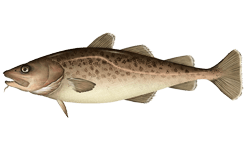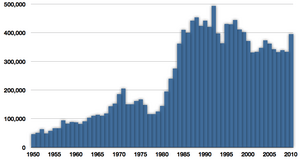Pacific cod facts for kids
Quick facts for kids Pacific cod |
|
|---|---|
 |
|
| Scientific classification | |
| Synonyms | |
|
The Pacific cod, also known as gray cod or grayfish, is a type of fish that lives at the bottom of the ocean. It is a ray-finned fish, which means its fins are supported by bony rays. This fish is found in the northern Pacific Ocean, mainly on the continental shelf (the shallow part of the ocean floor near land) and deeper slopes.
Pacific cod can live in waters as deep as 900 meters (about 3,000 feet). They can grow to be about a meter (39 inches) long and weigh up to 15 kilograms (33 pounds). These fish often swim together in large groups called schools. They are an important fish for people to catch and eat. Fishing for them is carefully managed to make sure there are enough fish for the future.
What Pacific Cod Look Like
Pacific cod have three separate dorsal fins (fins on their back). They also have whiskers, called barbels, on their lower jaw, which look a bit like a catfish's whiskers. These whiskers help them find food on the ocean floor.
In appearance, the Pacific cod is quite similar to the Atlantic cod. They live mostly along the continental shelf and upper slopes. Their home range stretches around the edge of the North Pacific Ocean. This includes areas from the Yellow Sea to the Bering Strait, along the Aleutian Islands, and south towards Los Angeles.
Scientists have studied the DNA of Pacific cod and another fish called the Greenland cod. They believe these two might actually be the same species. If this is true, it would mean Pacific cod live in an even wider area, including parts of the Arctic Ocean.
Fishing for Pacific Cod

Pacific cod is a very important fish for commercial fishing. This means many people catch them to sell as food. In the past, the amount of Pacific cod caught increased a lot. For example, in the Northeast Pacific, catches grew from less than 1,000 tonnes in 1979 to over 430,000 tonnes in 1995.
Today, the amount of Pacific cod that can be caught is strictly controlled. This is done through something called "quotas." A quota is a limit on how much fish can be caught. These quotas are divided among different fishing methods. Some fishers use hook and line gear, others use pots, and some use bottom trawls (large nets dragged along the ocean floor). These rules help protect the fish population.
Protecting Pacific Cod
Some groups of Pacific cod are being watched carefully by scientists. For example, the Pacific cod living in the Salish Sea (a body of water between British Columbia and Washington State) are considered a "Species of Concern" by the U.S. National Marine Fisheries Service.
Being a "Species of Concern" means that the U.S. Government's National Oceanic and Atmospheric Administration (NOAA) is worried about their numbers and the threats they face. However, there isn't enough information yet to say if they need to be listed under the U.S. Endangered Species Act (ESA). The ESA is a law that protects animals and plants that are in danger of disappearing forever. Scientists continue to study these fish to make sure they stay healthy in the ocean.
Images for kids
-
Adult Pacific cod caught on jigging gear



